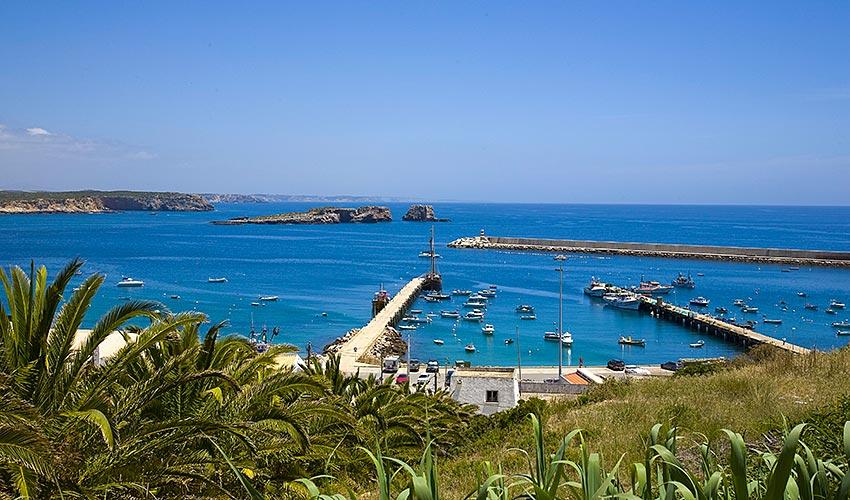Sagres is home to the most impressive landscape in the Algarve. The force of Nature is so strong in this south-westerly tip of continental Europe that visitors will soon understand why ancient settlers deemed it sacred, how it lured 15th Century Portuguese explorers to set sail into the unknown and how it has managed to retain its original striking beauty.
Sagres’ history has been defined by its geographic location and the stunning landscape of the Sagres and Cape St. Vincent promontories. The land’s-end feel of these 50 metre (164 feet)-high headlands dropping dramatically into the sea were a constant source of mystery and attraction to the region’s successive settlers as the various traces of their presence show. The most influential figure in Sagres’ history was Henry the Navigator, who found inspiration here to embark on his exploratory journeys, bringing fame to the region and leading to the creation of the town of Vila do Infante. Under his guidance, the area became a hub of maritime activity as cartographers, astronomers and mariners congregated, caravels were built and the exploration of the coast of Africa began.
The wild, rugged landscape of Sagres and the force and attraction of the sea continue to enthral visitors. The dramatic embankments and long, sandy beaches of the coast north of Cape St. Vincent have made them a favourite with surfers, paragliders and those who prefer untamed, natural surroundings. The southern coast offers more alternatives. Exposed beaches such as Tonel have helped to make Sagres the surfing capital of the Algarve while more sheltered ones like Mareta or Martinhal are family favourites that continue to retain a natural, unspoilt feel to them. These are especially popular with scuba divers and snorkelers, who take great pleasure in exploring the underwater grottoes of Mareta’s limestone cliffs or the islets facing Martinhal. Travelling eastwards along this southern coast, long stretches of sand alternate with small coves nestling between cliffs, the least accessible of these often providing blissful beaches of near seclusion.
Sagres is a lively fishing town with a picturesque harbour in Ponta de Baleeira, which becomes particularly busy at the end of the day when the fishermen return with their daily catch. A number of boats providing fishing, dolphin spotting or scenic trips around the impressive coastline also depart from here. The town’s central square, Praça da República, is a pleasant spot in which to watch the world go by and enjoy a taste of the local gastronomy. Fish is the staple ingredient of most of the dishes and the assortment is remarkable, with everything from gooseneck barnacles, cuttlefish or fried moray eel served in a variety of succulent ways. The summer months bring many a lively night to the bars of Sagres as surfers flock to the beaches and enjoy the annual surf festival that is staged here. The nearest beach, Praia da Mareta, lies a short walk south from the centre of town.
While the beach-lovers soak up the sun, inveterate golfers can enjoy the beautiful sea views while testing their skills on the rolling hills of the Parque da Floresta golf course, situated near the village of Budens.
Places to see
Historical sites on Ponta de Sagres (Sagres promontory):
Fortaleza de Sagres (Sagres Fortress)
Listed as a national monument, Henry the Navigator’s original 15th Century fortress was destroyed during Sir Francis Drake’s 16th Century incursions on the southern coasts of Spain and Portugal and rebuilt in the 16th, 17th and 18th Centuries.
Rosa dos Ventos (Wind Rose)
Attributed to Henry the Navigator, this 43 metre (141 feet)-diameter circle with 32 spokes marked out with stones, was unearthed in 1921. Commonly believed to be a wind rose, some scholars argue that it may have been a sun dial.
Igreja de Nossa Senhora da Graça (Church of Our Lady of Grace)
Built on the foundations of Henry the Navigator’s original Santa Maria church, this 16th Century church features an image of St. Vincent that came from the convent of Cape St. Vincent, the tomb of a 16th Century Spanish captain who helped defend the fortress from Sir Francis Drake’s attack in 1587 and the tombs of two 17th Century fortress commanders.
Historical sites on Cabo de São Vicente (Cape St. Vincent):
Fortaleza (Fortress)
King D. João III ordered this fortress to be built in the 16th Century to protect the Franciscan convent lying alongside it from pirate attacks. The main gate bears the king’s coat of arms. The tower was destroyed by Sir Francis Drake and rebuilt in the 17th Century.
Farol do Cabo São Vicente (Cape St. Vincent lighthouse)
Originally built in 1846, the lighthouse has been successively enlarged and modernised since. It is considered to be one of the most powerful lighthouses in Europe and guards one of the world’s busiest shipping lanes.
Archaeological sites in the Sagres region:
Megalithic monuments
The landscape around the Sagres region is rich with evidence of the Algarve’s prehistoric past, confirming the belief that the Sagres and Cape St. Vincent promontories were held to be sacred places of worship. A large number of menhirs and cromlechs dating from the 4th-3rd Centuries BC are scattered across the region, the most notable examples of which can be found in Aspradantas, Milrei, Padrão and Monte dos Amantes.
Roman ruins
Sagres’ name is derived from the sacred name that the Romans gave this headland, Promontorium Sacrum, the place where the setting sun made the waters boil. The most significant ruins in the region include a villa, baths and fish salting tanks in Boca do Rio and the remains of a villa and fish salting tanks at Salema beach. Martinhal beach contains the remains of a large pottery centre with three kilns used for making amphorae. Ruins of fish salting tanks can also be found on the small islands of Martinhal lying opposite this beach.
Recommended Sagres Hotels

 English
English  Português
Português  Deutsch
Deutsch 



